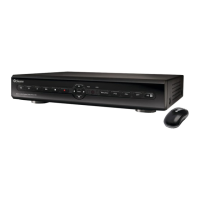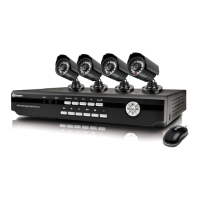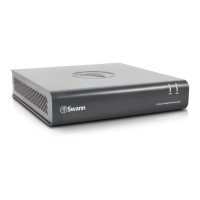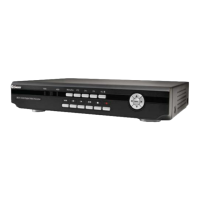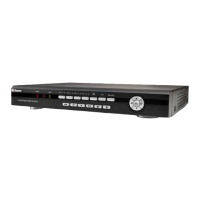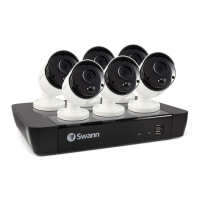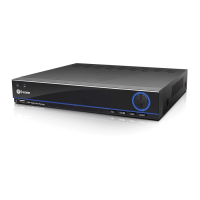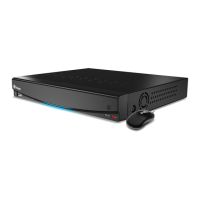
Do you have a question about the Swann H.264 and is the answer not in the manual?
| Video Compression | H.264 |
|---|---|
| Video Inputs | 4, 8, or 16 channels (depending on model) |
| Video Outputs | HDMI, VGA (depending on model) |
| Network Interface | Ethernet (RJ-45) |
| USB Ports | 2 |
| Remote Access | Yes, via SwannView Link app |
| Hard Drive Support | 1 SATA HDD |
| Remote Viewing | Yes |
| Motion Detection | Yes |
| Alerts | Email alerts |
| Backup Options | USB |
Details FCC compliance, interference correction, eavesdropping prohibition, and safety instructions.
Explains default login credentials and recommends changing them for privacy.
Outlines the three stages for setting up the DVR, including default settings.
Provides essential guidelines for safe and proper DVR installation, including environmental and physical considerations.
Explains the function of the infrared sensor for remote control reception.
Describes the hard drive indicator light's behavior during activity.
Details the power indicator LED, showing connection and power status.
Identifies the USB 2.0 port for external storage and firmware updates.
Identifies the DC power input and the PTZ (RS485) port for device control.
Details the audio outputs, audio inputs, and primary video inputs.
Describes HDMI and VGA outputs and the network port for connectivity.
Describes the eSATA port for connecting external hard drives.
Illustrates connecting cameras to power and the DVR's BNC inputs.
Shows connecting the DVR to a display via HDMI/VGA and to a router via Ethernet.
Depicts connecting the mouse to the DVR's USB 2.0 port.
Explains the use of audio ports and the PTZ port for external devices.
Details connecting external USB hard drives for storage and backup.
Highlights the USB mouse for easy DVR operation and describes its functions.
Discusses remote control usage and wireless mouse compatibility.
Explains default login credentials and recommends changing them for privacy.
Introduces the automated setup wizard for initial DVR configuration.
Covers language, video standard, resolution, time zone, and date format settings.
Explains hard disk management for initialization, formatting, and space monitoring.
Guides on network setup, recommending DHCP and UPnP for ease of use.
Explains Dynamic DNS setup for assigning a fixed address for internet access.
Guides on configuring email alerts for detected alarm events.
Explains Network Time Protocol for automatic time synchronization.
Guides on configuring Daylight Saving Time adjustments.
Explains setting up user accounts with different access levels.
Guides on completing the setup wizard and managing its startup display.
Introduces MyDVR software for remote access and configuration.
Lists minimum PC requirements and supported operating systems for MyDVR.
Provides a link for Mac users to find compatible remote access software.
Lists prerequisites for running MyDVR, including network connection.
Guides on logging into MyDVR via a local network connection.
Explains logging into MyDVR over the internet using IP or DDNS.
Explains default login credentials and recommends changing them for privacy.
Describes the default live-view screen of MyDVR, showing camera feeds.
Explains the playback interface and backup links for reviewing footage.
Details accessing local and remote configuration menus within MyDVR.
Covers viewing modes, volume control, and CPU usage optimization tips.
Explains customizing where MyDVR stores recordings, downloads, and snapshots.
Covers converting footage to AVI and configuring auto-login.
Offers troubleshooting advice for playback issues, recommending VLC player.
Covers channel name display, record data overlay, and privacy mask settings.
Details encoding parameters, streams, audio, resolution, frame rate, and bitrate.
Covers overwrite, pre-record, delay, and pack duration settings.
Explains setting up recording schedules for channels on specific days.
Covers network access types, IP addressing, and DNS server configuration.
Details DDNS, NTP, Email settings, port settings, and UPnP.
Guides on setting up motion detection for channels, including actions.
Explains video loss definition, monitoring, and associated actions.
Covers defining exception types and actions for events like HDD errors.
Explains configuring the DVR to operate PTZ devices, including settings references.
Covers changing system standard, date format, and device ID.
Introduces the Swann View app for remote viewing on mobile devices.
Provides the URL for downloading mobile apps and guides.
Explains on-screen indicators and methods to access the DVR's main menu.
Details the function of each control button on the DVR's local interface.
Explains default login credentials and recommends changing them for privacy.
Outlines menu options related to displaying camera feeds and output settings.
Lists menu items for encoding, options, and scheduling recordings.
Covers menu options for playback, backup, and log searching.
Details menu items for general, advanced, and status settings.
Lists menu options for motion, video loss, and exceptions.
Covers menu items for HDD, S.M.A.R.T., and PTZ device settings.
Details menu options for general, user, information, and maintenance settings.
Lists menu options for locking, shutting down, and rebooting the DVR.
Guides on modifying the DVR's recording schedule for optimal settings.
Explains setting up email notifications for detected motion events.
Details how to adjust motion detection parameters for better performance.
Provides guidance on configuring PTZ devices, referencing specific pages.
Covers camera number, name, OSD position, and record date settings.
Details adjusting brightness, contrast, saturation, and hue for camera images.
Explains creating privacy masks to obscure parts of the image.
Covers resolution, transparency, mouse sensitivity, dwell time, audio, and border adjustments.
Provides notes on audio transmission via HDMI and required resolutions.
Details camera selection, encoding parameters, streams, and audio recording.
Explains setting image resolution and frames per second for recording.
Explains setting the maximum data rate for video recording.
Covers overwrite, pre-record, post-record, and pack duration settings.
Provides key advice for programming recording schedules and using copy functions.
Details recording modes: Normal, Motion, and None.
Guides on selecting channels, video types, and timeframes for playback.
Discusses DVR resource allocation between recording and playback.
Outlines steps for backing up footage using USB drives and the file list.
Explains converting footage to AVI format for backup compatibility.
Shows progress meters for the backup and transcoding process.
Explains the menu for searching recordings triggered by motion detection.
Describes the log search feature for viewing system events.
Details playback controls like hide console, exit, position, volume, play, and speed.
Explains identifying normal vs. motion/alarm recorded footage.
Warns about potential performance reduction during simultaneous recording and playback.
Covers network access types, IP addressing, subnet mask, and gateway.
Explains DNS server configuration options for DHCP and static setups.
Notes the DVR's unique MAC address.
Details configuring DDNS for remote access and NTP for time synchronization.
Guides on configuring email alerts and advanced IP filtering.
Explains port settings and the benefits of enabling UPnP.
Differentiates static and dynamic IP addresses and how to identify them.
Provides options for managing dynamic IP addresses, including using DDNS.
Recommends SwannDVR for DDNS service and provides account setup guidance.
Guides on setting the time zone for NTP synchronization and DST compatibility.
Explains using the IP filter to control device access to the DVR.
Describes the network status screen for viewing network configuration.
Guides on configuring email alerts for events and status updates.
Recommends Gmail for its ease of setup and reliability for DVR alerts.
Details SSL/TLS, SMTP server, sender, recipient, attachments, and interval.
Explains the process of detecting motion by comparing consecutive frames.
Addresses compatibility issues with wireless cameras and PTZ systems.
Guides on setting motion detection areas and defining actions upon detection.
Guides on setting up the motion detection area using a grid.
Explains adjusting motion detection sensitivity on a scale from 0 to 50.
Details setting sensitivity for different time periods of the day.
Recommends testing sensitivity with a volunteer for optimal settings.
Discusses compatibility with cameras and PTZ systems, and wireless camera warnings.
Provides tips on reducing false triggers via masking, sensitivity, and image adjustments.
Offers advice on prioritizing notifications, legal records, and critical events.
Details actions for motion detection: audio warning, email, and triggering other cameras.
Explains video loss definition, monitoring, and associated actions like audio or email.
Lists exception types like HDD Full, HDD Error, Net Disconnected, and IP Conflict.
Covers actions for exceptions: audio warning and sending email alerts.
Explains the list showing the internal SATA HDD and its status.
Notes that USB drives are not listed for recording due to bandwidth limitations.
Explains S.M.A.R.T. for monitoring hard drive health and status.
Guides using S.M.A.R.T. information to diagnose HDD errors.
Explains configuring the DVR to operate PTZ devices.
Warns against using motion detection with PTZ cameras.
Provides notes on remote PTZ control and potential latency.
Details camera selection, baud rate, data bits, protocol, and address.
Details controls for camera movement, speed, zoom, focus, and iris.
Explains defining and initiating PTZ presets and patrol modes.
Guides on accessing PTZ menus and settings.
Covers selecting language and changing between PAL and NTSC video standards.
Emphasizes setting the correct time zone and configuring DST.
Covers system time, password protection, and auto lock time.
Explains assigning a unique ID to differentiate DVRs on a network.
Explains the user management menu for defining access levels.
Recommends password protection for the admin account due to its full access.
Guides on adding, deleting, and modifying user accounts.
Explains customizing access via configuration and operation tabs.
Explains the purpose of the System Information screen, often for technical support.
Identifies the device name and lists technical details for support.
Recommends periodic rebooting for DVR stability and operational integrity.
Guides on setting up automatic DVR reboots.
Explains updating the DVR's firmware, with a reminder to export settings.
Guides on restoring factory default settings.
Explains creating and loading backup configuration files.
Addresses issues with black/white or flickering camera images, linking to System General settings.
Troubleshoots login issues, default passwords, and forgotten passwords.
Addresses missing menus, possibly due to hard drive issues.
Provides methods to reduce false motion triggers via masking, sensitivity, and image adjustments.
Troubleshoots excessive email alerts, suggesting interval adjustments or motion detection tuning.
Points to hardware or configuration faults for recurring errors.
Discusses DVR operation with routers that don't support DHCP or require static addressing.
Guides on finding network IP, creating a unique IP, and assigning it to the DVR.
Provides guidance on port forwarding for routers without UPnP.
Lists video compression, video system, and operating system details.
Details input/output ports and supported display resolutions.
Lists recording features like frame rate, bitrate, and modes.
Details HDD, USB, PTZ, LAN, and network protocol specifications.
Lists included accessories and physical dimensions/weight.
Outlines the product's warranty period and terms.
Details consumer guarantees applicable in Australia.
Provides contact information for Swann Technical Support, including email.
Lists toll-free telephone numbers for technical support in different regions.
